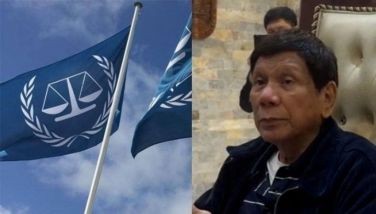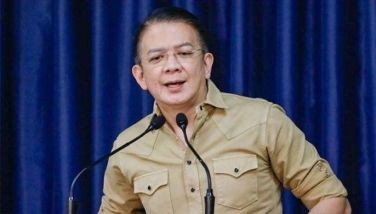The return of Arthur Yap

October 26, 2006 | 12:00am
 I’m glad Arthur Yap is back as Secretary of Agriculture. Never mind the muddled thinking of sectors who perceive his reappointment as a revenue-making move for the Arroyo administration’s foray in the next election. So what else is new? Any good intention of the President is always perceived negatively by the opposition anyway.
I’m glad Arthur Yap is back as Secretary of Agriculture. Never mind the muddled thinking of sectors who perceive his reappointment as a revenue-making move for the Arroyo administration’s foray in the next election. So what else is new? Any good intention of the President is always perceived negatively by the opposition anyway.
My opinion is that Yap, who still retains the position of Presidential Adviser on Job Creation, is qualified for the job, as he was for the job of Director General of the Presidential Management Staff, a most powerful position in the Cabinet. (The PMS by the way has now been turned over to Secretary Cerge Rimonde, who previously handled the government media).
Unperturbed by the strident sounds of the opposition, Yap is determined to do a good job. He says, "The Department of Agriculture cannot isolate itself and merely think in terms of commodities and yields. It must lend itself to the accomplishment of goals and programs that will create more jobs and investments in the countryside, increased food production and the rise of farmer and fisher-folk incomes nationwide."
To that end, DA programs, he said, must move towards infrastructure projects, research and technology dissemination (extension services with the Local Government Units), micro and small and medium enterprise finance, and support for our young farmers. Hard infrastructure projects include irrigation, roads, bridges, warehouses and post-harvest facilities.
That is why the President, said Yap , has unveiled a very strong infrastructure program from now until 2010. She has ordered three major irrigation programs in North Luzon (Agno, Casecnan and Banaoang Irrigation projects) and the Kabulnan Irrigation project in Mindanao. These will add 100,000 additional hectares of arable rice lands and produce enough rice to cut by 30 percent the national importation by 2010. Also being prioritized is the repair of over 400,000 hectares of irrigation service areas and the building of small water impounding works.
Yap calls for utilization of new technologies such as better water management, farming techniques, biotechnology and production and post harvest farm equipment; better seeds and inputs, and a strong micro and SME financing program with private sector tie-ups and the LGUs, to bring about higher yields.
Yap’s projects are aimed at helping people afford the cost of food. Tie-ups between the DA and private corporations included support of hybrid and certified rice producers, facilitating transport of goods, and lowering of prices of pork and vegetables.
The conference series, which is unprecedented in the local scene, began with the National Competitiveness Summit held last October 6. It was a business sector-academe-government forum on competitiveness held at the Heroes’ Hall in Malacañang. That government-led summit was followed by five other conferences organized by the Joint Foreign Chambers (JFC), Management Association of the Philippines (MAP), Makati Business Club (MBC), PhilExport and the Semi-Conductors and Electronics Industry of the Phils. (SEIPI). The last, concluded last Friday, was the 32nd Philippine Business Conference organized by the Philippine Chamber of Commerce and Industry (PCCI).
It is interesting to note that a review of constitutional and legal impediments in doing business in the Philippines was among the top recommendations of the foreign chambers. The matter was tackled in one of the workshops of the Foreign Direct Investment Forum, wherein representatives of foreign investors drew up an action plan on how the Philippines could attract $3 billion a year in foreign direct investments (FDIs).
In his presentation, Dr. Michael Clancy, president and CEO of the Philippine Business Leaders Forum, indicated that $2.94 billion in FDIs could be generated per year over the next four years if constitutional and legal impediments were addressed immediately.
Dr. Clancy described this as the "take-off" scenario, which would bring about FDI increases at a rate of 25 percent per year – almost at par with the 30 percent increases in FDI flows to Asean over the past five years. Aside from giving immediate attention to the constitutional and legal impediments to doing business here, key assumptions to this economic take-off are global growth at around 3.6 percent per annum, improving governance and discouraging rent-seeking behavior, and completion to international standards of some major infrastructure projects.
He added that improving governance and discouraging rent-seeking behavior would be a precursor for major investments into the mining, infrastructure and energy sectors. Rent-seeking behavior is scientific speak for graft and corruption, which leads to an uneven playing field for those doing business in any country. He added that completing major infrastructure projects according to international standards would evoke Filipino pride and our commitment to excellence, and thus encourage more FDIs.
The matter has obviously been studied thoroughly by the foreign chambers, whose recommendations came with a detailed account of investment prospects in industries that the 1987 Constitution has restricted from foreign investments. According to Dr. Clancy’s presentation, if we remove any restrictions on foreign ownership of land, we would open up our economy to some 1,000 non-retiree foreigners who buy land. Given a budget of about $50,000 each, these non-retiree foreigners could easily put in $50 million per year. It added that if we remove any restrictions on foreign ownership of educational institutions and mass media, $10 million in FDIs could flow into each sector per year. Moreover, if 100-percent foreign ownership were allowed in public utilities, foreign investors could come in with $2.5 billion in fresh investments between 2009 and 2010. Finally, if the FDI threshold in retail and non-retail businesses were removed, 500 new firms in each sector could come in. At the minimum, these new firms would pump some $50 million in fresh funds into these sectors.
The foreign chambers’ take-off scenario assumes that Congress would pass constitutional amendments by next year and implement the legislation by 2008.
Thanks to the nationwide campaign that the Charter Change Advocacy Commission (Adcom) conducted since February this year, Cha-cha is no longer as threatening as its critics paint it to be. There are millions of Filipinos who now find it acceptable, and welcome whatever benefits it may bring. I guess to most of us, it’s just our way of telling our politicians: "Anything but this, please!"
This sentiment has been echoed by the foreign chambers. "The faster solutions are implemented, the faster the Philippines will be perceived as more competitive, the more domestic and foreign investment will become available to build the globally-competitive Philippine economy and the more jobs will be created. However, if the country merely continues to muddle through with a ‘business-as-usual’ approach, it will not become more competitive, unemployment and unrest will increase, and the great potential of the Philippines will remain unrealized," the JCC warned in a statement signed by the presidents of the American Chamber of Commerce of the Philippines, Inc.; Australian-New Zealand Chamber of Commerce of the Philippines, Inc.; Canadian Chamber of Commerce of the Philippines, Inc.; European Chamber of Commerce; Japanese Chamber of Commerce of the Philippines, Inc.; Korean Chamber of Commerce & Industry of the Philippines, Inc.; and the Philippine Association of Multinational Companies Regional Headquarters, Inc.
The message couldn’t be clearer: It’s now or never.
My e-mail: dominimt2000@yahoo.com
BrandSpace Articles
<
>
- Latest
- Trending
Trending
Latest




























